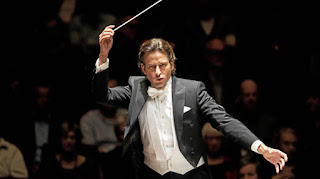ISO program explores the exotic, both buoyant and bizarre
 |
| Spanish conductor Gustavo Gimeno made a good impression with the ISO. |
I don't know if in fact jazz musicians who are musically aware outside their genre have a thing for "The Miraculous Mandarin." But I can see why they might, after enjoying the Indianapolis Symphony Orchestra's performance of the suite Sunday evening at Hilbert Circle Theatre.
Compared to Milhaud's masterpiece, "The Miraculous Mandarin" carries no reflection of jazz.
But in the shortened suite version of the Hungarian composer's "pantomime of gestures," the lurid scenario drew from him the spirit of improvisation. Just about any music based upon a stage presentation or a story will have picturesque referents to that story, of course. But something about the offhand, cobbled-together criminal scheme that animates "The Miraculous Mandarin" inspired Bartok to lard his score with bizarre, exploratory solo passages as well as smears and cacophony for ensemble. The result very nearly anticipates the spirit of free jazz: Whether consciously or not, Ornette Coleman and the Art Ensemble of Chicago were inheritors of the "Mandarin" aesthetic.
Guest conductor Gustavo Gimeno of Spain led a piquant, highly charged account of the score. Such vivid solos from bassoon, clarinet, English horn and others! Such ripping outbursts from brass and percussion! The abrupt shifts of timbre and mood — all of them overhung with the urgings of easy money, violence, and sex — were boldly outlined. This is a conductor of uncommon insight and flair, none of it superficially choreographed: Gimeno's posture is ramrod-straight, his gestures large-scaled but also concise and efficient, the tactus high and clear.
He also has fresh ideas about familiar scores. A couple of months ago when we visited Dallas to hear the orchestra my son Theodore is in, I was struck by how Gimeno, in another guest-conductor gig, handled the "Gavotte" movement in Prokofiev's "Classical" Symphony. Swerving from the conventional manner of honoring the French court dance with a patrician flow, he gave a slight Slavic oomph to its rhythms. The suggestion of subtly stomping feet worked quite well, especially taking into account Prokofiev's inclination toward parody.
In the ISO engagement Saturday, his interpretation of Ravel's Mother Goose Suite constantly upheld the fantasy or fairyland element. As transparent as Ravel's writing is, Gimeno drew from the orchestra a suggestion of dreamland that meant, among other things, a quite slow pace in the opening and closing movements — "Pavane of the Sleeping Beauty" and "The Enchanted Garden" — which in the latter piece made the wedding celebration at the very end all the more festive.
Furthermore, he made Tchaikovsky's fantasy overture, "The Tempest," more fascinating than its potboiler lineaments outwardly suggest. At the outset, the horn calls over wavering strings conjured up the mystery of Shakespeare's play. In addition to teeth-rattling storm episodes, there is a plethora of lyrical writing that brought forth full-bore playing. If not from Tchaikovsky's top drawer in the melodic department, it was quite alluring, rising to huge string unisons toward the end. Unanimity in the matter of violin bowing would have been welcome, however.
 |
| Javier Perianes caught the flash and filigree of Saint-Saens. |
I once called it a period piece, in a review mainly commenting on Dvorak's Seventh Symphony. This isn't to dismiss such music as never worthy of being played: A period piece of stature can fill today's listener in on aspects of a composer's personal experience and his times; it just doesn't "live" the way a work with perennial appeal does. It seems locked into its milieu, but from time to time it can also speak to ours.
The "Egyptian" is rife with the Orientalism that was in vogue in late 19th-century France. It reached out to embrace the charm of non-European cultures, but in a superficial touristy way. There are moments in this concerto in which Saint-Saens wears his usual guise as a Frenchified Beethoven, and there is a spectacular finish to the piece that readily brought Saturday's audience to its feet.
But most of the work is awash in facility, distributed neatly enough to avoid the impression of merely drifting. Perianes was thoroughly equal to everything the work seems to require of its soloist, and Gimeno was an unexceptionable partner in leading the accompaniment. Called back for an encore, Perianes showed equal command of another idiom: Chopin's in the Prelude in C-sharp minor.



Comments
Post a Comment